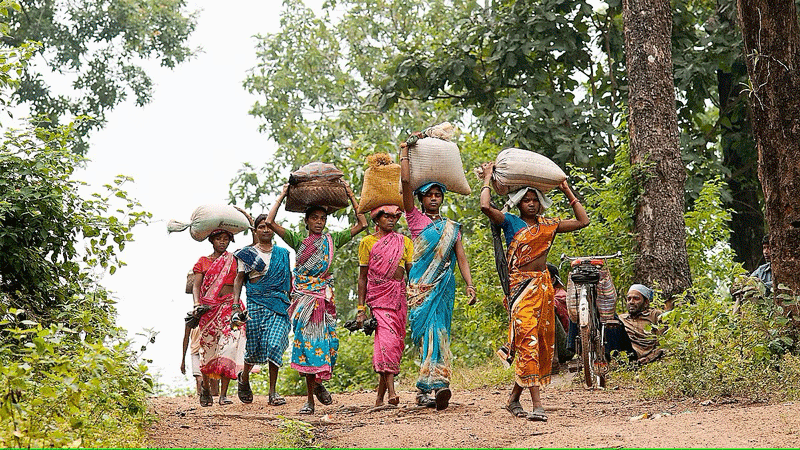
In India, the commons have played an important role in the livelihoods of the village poor for centuries. The commons refer to the natural resources that are collectively owned and managed by the community, such as forests, grazing lands, and water bodies. In this blog post, we will explore the various products that the village poor used to collect from the commons for their livelihoods.
- Timber and Firewood: Timber and firewood are important resources that the village poor used to collect from the forests. Timber was used for building homes, making furniture, and for fuel. Firewood was used for cooking, heating, and for firing kilns to make pottery. In India, teak and sal are two commonly used types of timber. However, over the years, the collection of timber and firewood has become unsustainable, leading to deforestation and degradation of the commons. Sustainable alternatives such as agroforestry and community-based forest management are being promoted to conserve these resources.
- Grazing Lands: Grazing lands are an important resource for the village poor who rely on livestock for their livelihoods. Cows, goats, and sheep are allowed to graze on the commons, providing milk, meat, and wool for the community. Grazing lands are managed by the community, and the benefits are shared by all members, promoting social cohesion and equitable distribution of resources. For example, in Rajasthan, the Bishnoi community has been practicing sustainable grazing management for centuries, which has helped conserve the local ecosystem.
- Medicinal Plants: The forests and other natural resources on the commons also provide a range of medicinal plants that the village poor use to treat various ailments. These plants have been used for centuries to cure illnesses, and the knowledge of their uses has been passed down from generation to generation. Some common medicinal plants in India include neem, turmeric, and aloe vera. However, over the years, the unsustainable collection of these plants has led to their depletion, and many have become endangered. Efforts are being made to promote sustainable practices such as agroforestry and the cultivation of medicinal plants to conserve these resources.
- Non-Timber Forest Products: Non-timber forest products (NTFPs) are products that are derived from the forest, such as honey, fruits, nuts, and fibers. These products are an important source of income for the village poor, who sell them in local markets. For example, the amla fruit is a common NTFP in India that is used for making jams, pickles, and other products. NTFPs are often collected sustainably, and the income generated from their sale helps to support the livelihoods of the community.
- Water Resources: Water resources, such as rivers, lakes, and ponds, are also important resources that the village poor use for their livelihoods. These resources provide water for irrigation, fishing, and for domestic use. For example, the traditional practice of building small check dams on streams and rivers is an effective way to recharge groundwater and improve water availability for agriculture. However, over the years, the unsustainable use of these resources has led to their degradation and pollution. Efforts are being made to promote sustainable practices such as rainwater harvesting and water conservation to ensure the continuity of these resources and the livelihoods of the village poor.
However, over the years, the unsustainable use of these resources has led to their degradation and depletion. It is important to promote sustainable practices like community-based management and the use of alternative sources of energy to ensure the continuity of these resources and the livelihoods of the village poor.
NS Jodha, an Indian economist and expert on rural development, conducted extensive research on the role of the commons in the livelihoods of the village poor in India. His research shows that the commons have played a crucial role in supporting the livelihoods of the rural poor for centuries, providing them with essential resources for food, shelter, and income.
Jodha's research highlights the importance of sustainable management of the commons. He argues that the commons can be a sustainable resource only if they are managed in a way that balances the needs of the community with the need to preserve the resource for future generations. This requires a collaborative approach, with the community and the government working together to develop policies and practices that promote sustainable use of the commons.
Jodha's research also emphasizes the importance of recognizing the role of the village poor in managing the commons. He argues that the traditional knowledge and practices of the village poor are often undervalued, but they are essential for ensuring the sustainable use of the commons. The village poor have developed a deep understanding of the local ecology and have developed practices that allow them to use the resources in a sustainable way.
It is important to promote sustainable practices, such as community-based management and the use of alternative sources of energy, to ensure the continuity of these resources and the livelihoods of the village poor. The research of NS Jodha has highlighted the diversity and complexity of the collectibles from the commons, and the need for sustainable management practices to ensure their continued availability for the benefit of future generations.
